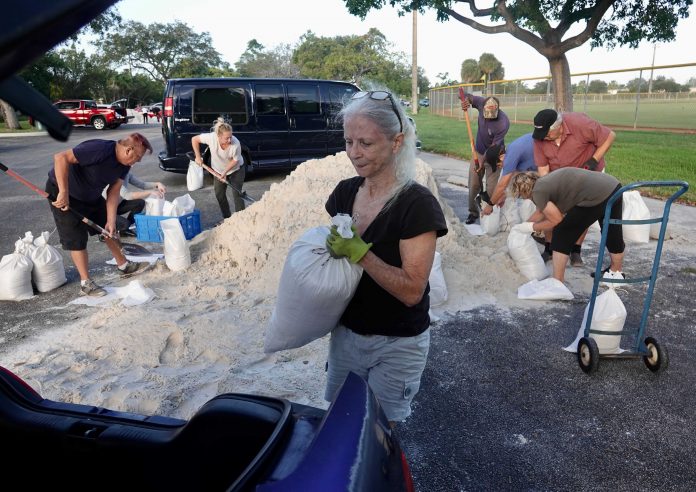
By FREIDA FRISARO and DANICA COTO Associated Press
MIAMI (AP) — Tropical Storm Nicole forced people from their homes in the Bahamas and threatened to grow into a rare November hurricane in Florida on Wednesday, shutting down airports and Disney World while prompting evacuation orders that included former President Donald Trump’s Mar-a-Lago club.
Hundreds of people sought shelter in the northwestern Bahamas before the approaching storm, which had already sent seawater washing across roads on barrier islands in Florida.
The U.S. National Hurricane Center said the center of the sprawling storm make landfall on Great Abaco island around midday with estimated maximum sustained winds of 70 mph.
“We are forecasting it to become a hurricane as it nears the northwestern Bahamas, and remain a hurricane as it approaches the east coast of Florida,” Daniel Brown, a senior hurricane specialist at the Miami-based National Hurricane Center, said earllier Wednesday.
Nicole is the first storm to hit the Bahamas since Hurricane Dorian, a Category 5 storm that devastated the archipelago in 2019, before hitting Florida.
In the Bahamas, officials said that more than 520 people were in more than two dozen shelters. Flooding and power outages were reported in Grand Abaco.
Authorities were especially concerned about a large Haitian community in Great Abaco that was destroyed by Dorian and has since grown from 50 acres (20 hectares) to 200 acres (80 hectares).
“Do not put yourselves in harm’s way,” said Zhivago Dames, assistant commissioner of police information as he urged everyone to stay indoors. “Our first responders are out there. However, they will not put their lives in danger.”
In Florida, the St. Lucie County Sheriff’s Office said in a tweet that storm surge from Tropical Storm Nicole had already breached the sea wall along Indian River Drive, which runs parallel to the Atlantic Ocean. The Martin County Sheriff’s office also said seawater had breached part of a road on Hutchinson Island.
Residents in several Florida counties — Flagler, Palm Beach, Martin and Volusia — were ordered to evacuate such barrier islands, low-lying areas and mobile homes.
There is no penalty for ignoring an evacuation order, but rescue crews will not respond if it puts their members at risk.
Disney World and related theme parks announced they were closing early on Wednesday evening and likely would not reopen as scheduled on Thursday.
Palm Beach International Airport closed Wednesday morning, and Daytona Beach International Airport said it would cease operations. Orlando International Airport, the seventh busiest in the U.S., was set to close at 4 p.m.. Further south, officials said Fort Lauderdale-Hollywood International Airport and Miami International Airport were experiencing some flight delays and cancellations but both planned to remain open.
At a news conference in Tallahassee, Gov. Ron DeSantis said winds were the biggest concern and and significant power outages could occur, but that 16,000 linemen were on standby to restore power, as well as 600 guardsmen and seven search and rescue teams.
Almost two dozen school districts were closing schools for the storm and 15 shelters had opened along Florida’s east coast, the governor said.
Forty-five of Florida’s 67 counties were under a state of emergency declaration.
Florida Division of Emergency Management director Kevin Guthrie said Floridians should expect possible tornadoes, rip currents and flash flooding.
Bahamas Prime Minister Philip Brave Davis, who is at the COP27 U.N. Climate Summit, drew attention to the link between storms and climate change.
Tropical storm force winds extended as far as 460 miles (740 kilometers) from the center in some directions.
It could intensify into a rare November hurricane before hitting Florida, where only two have made landfall since recordkeeping began in 1853 — the 1935 Yankee Hurricane and Hurricane Kate in 1985.
New warnings and watches were issued for many parts of Florida, including the southwestern Gulf coastline which was devastated by Hurricane Ian, which struck as a Category 4 storm on Sept. 28. The storm destroyed homes and damaged crops, including orange groves, across the state. — damage that many are still dealing with.
In Florida, the “combination of a dangerous storm surge and the tide will cause normally dry areas near the coast to be flooded by rising waters moving inland from the shoreline,” the hurricane center said.
Early Wednesday, President Joe Biden declared an emergency in Florida and ordered federal assistance to supplement state, tribal and local response efforts to the approaching storm. The Federal Emergency Management Agency is still responding to those in need from Hurricane Ian.



















